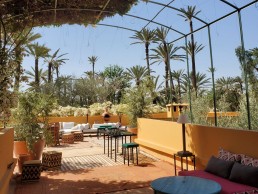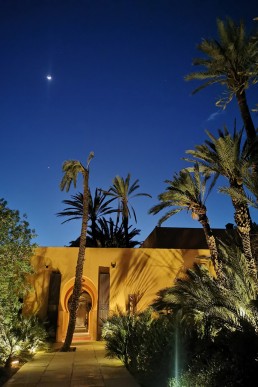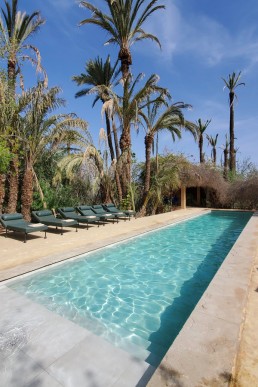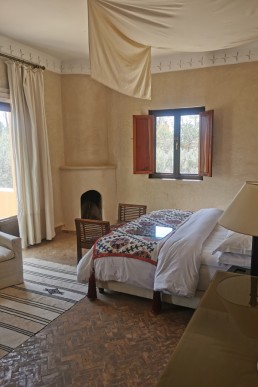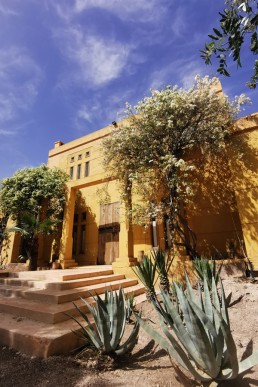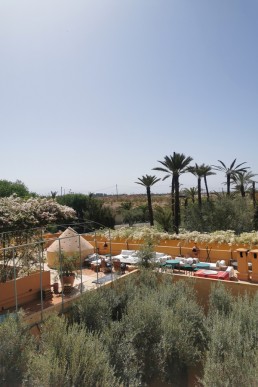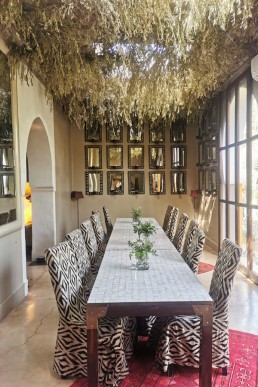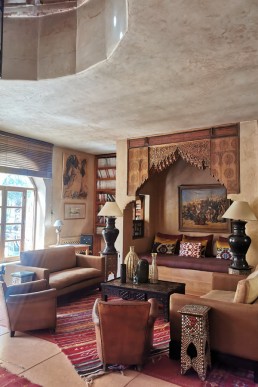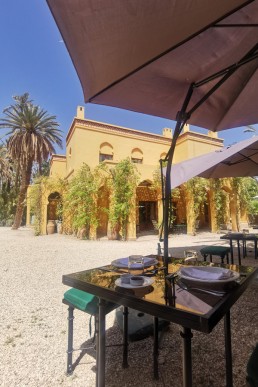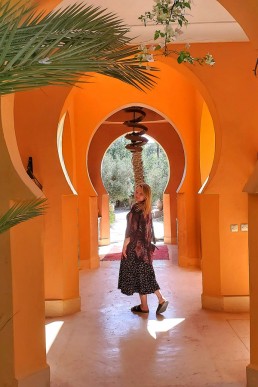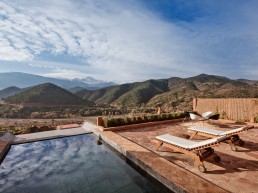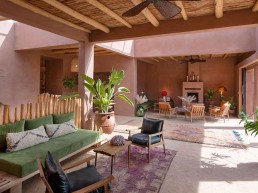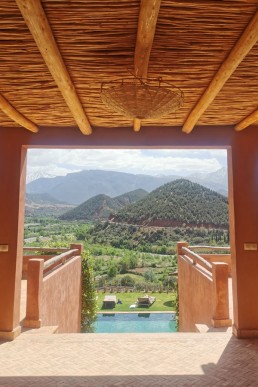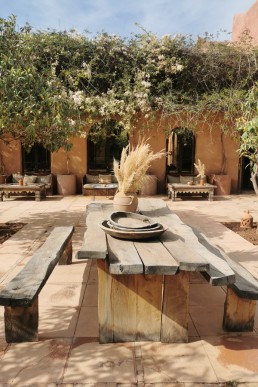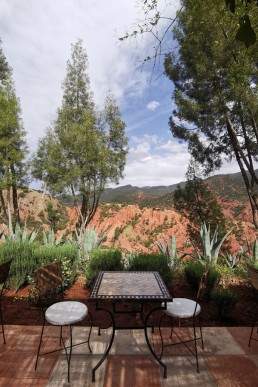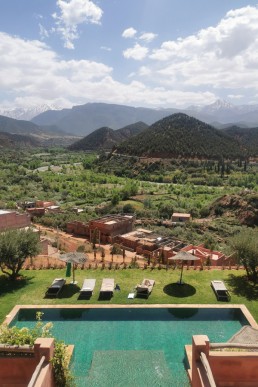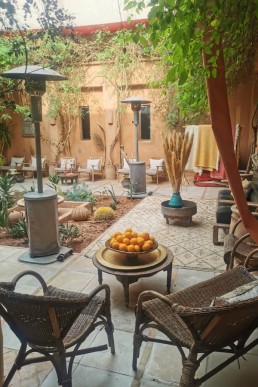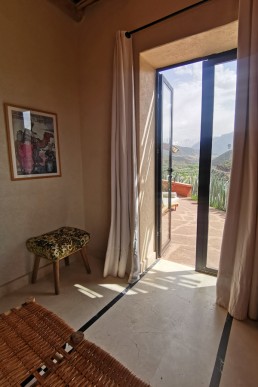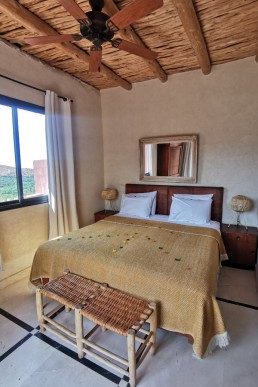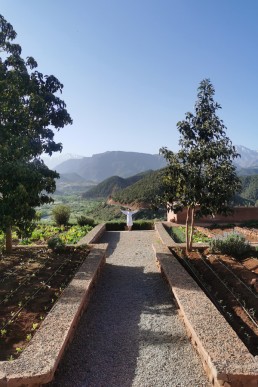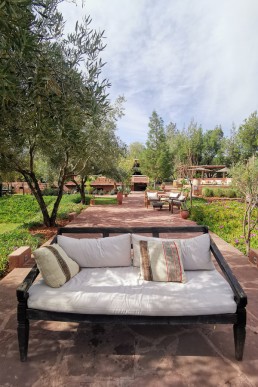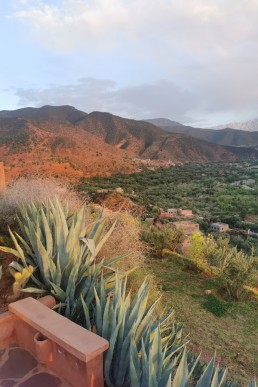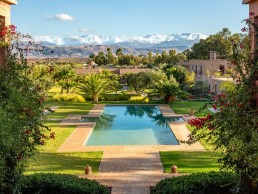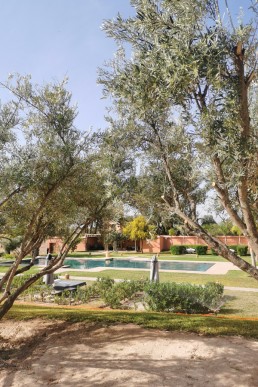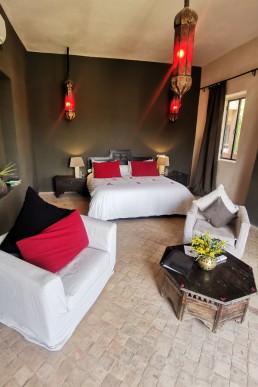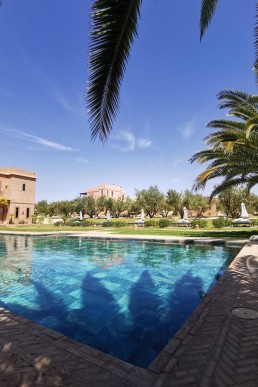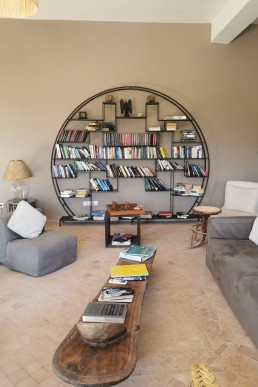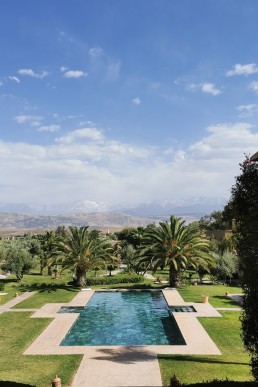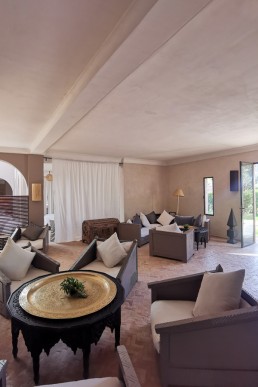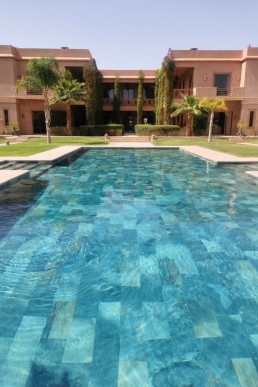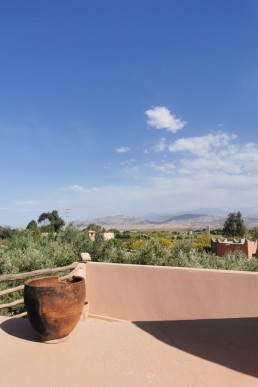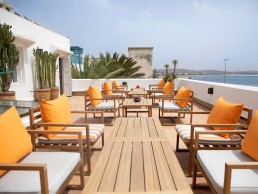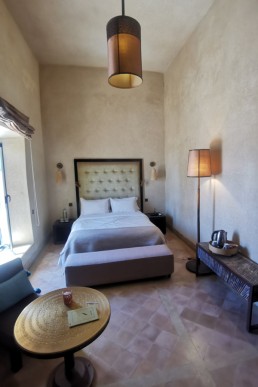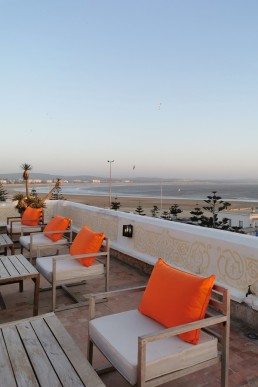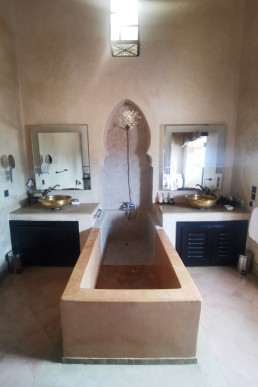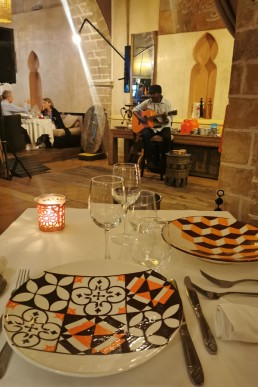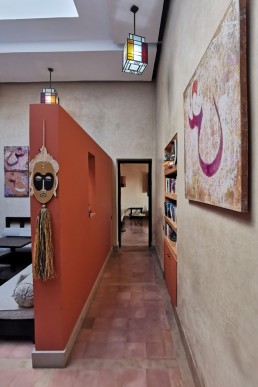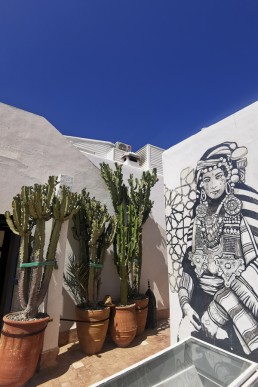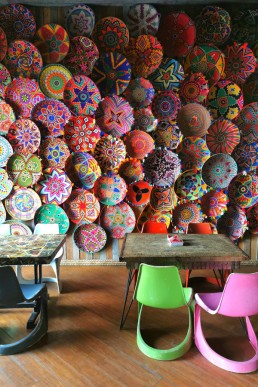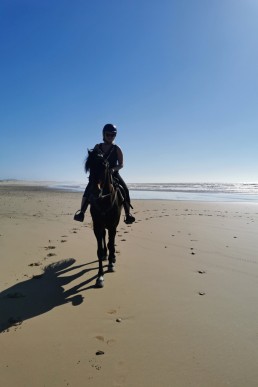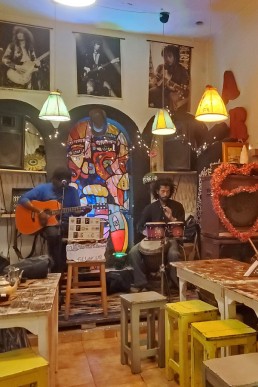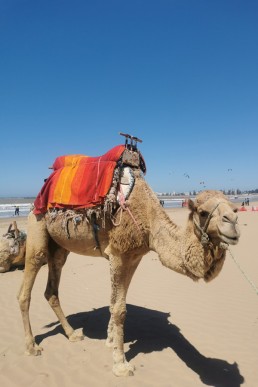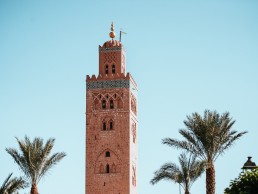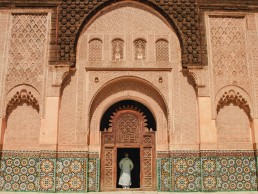
By Marta Purwin, Bookings Consultant
Find out how Marta and her partner got on navigating Morocco’s souks, ascending the High Atlas, and kicking back on the Atlantic coast, all during the holy month of Ramadan.
For us, Morocco offered just the right dose of exoticism to make us feel worlds away from home, yet it was conveniently close enough for a budget flight on Ryanair to whisk us there in under 3 hours. I had some misconceptions before going, like concerns about safety, the scorching heat, and a lack of understanding of the local culture and customs. Plus, we had somehow overlooked the fact that we would be arriving three days into Ramadan. A part of me was tingling with curiosity and excitement, but I also had nagging questions: Will restaurants be open? Will we be able to drink?! This trip would be a huge learning curve for me.
Stop 1: Jnane Tamsna, Marrakech
Our journey began in Marrakech, and our first stop was Jnane Tamsna. It’s situated in the picturesque Palmeraie, a short 15-minute taxi ride away from the Medina, and only 20 minutes from the airport. The secluded 22-hectare estate has 24 rooms scattered among five houses, each with its own pool, and spacious verandas overlooking the expansive gardens. We were relieved to return to such a peaceful retreat after a day in the hectic Medina (26,000 steps through the souks!), and having five pools to choose from in the Moroccan heat was certainly a godsend (two are heated in winter).
We were struck by the wonderful feeling of space, light and colour. Grand domes graced the entrance, and the Moorish arches were painted in a warm butterscotch hue, offering a picturesque contrast to the bright blue skies and surrounding greenery. To reach our room, we wandered down winding pathways, covered walkways and past fragrant palm and olive trees – a real treat for the senses.
Meryanne and Gary Martin are the dynamic owners, and their knowledge of Morocco infuses every nook and cranny of the house. Gary, the green-thumbed wizard and master ethnobotanist, tends to the lush gardens, while Meryanne, the chic French-Senegalese designer, applies her artistic eye to the interiors. Her on-site design atelier is a treasure trove of woven fabrics, lampshades, pillows, ceramics, glassware and jewellery – bring a spare suitcase, you’ll want to stock up on treasures!
We were impressed by how seamlessly they have combined the essence of a private home with the luxuries of a high-end hotel. Every detail was exquisite, from the curated collection of contemporary African art to the array of books and souvenirs that adorned the walls and shelves. There’s a pleasing mix of Moroccan craftsmanship, Middle Eastern decor, and vibrant African textiles in every room, all reflecting the passions and travels of the Martin family. The Jaipur Room, where we stayed, was beautifully styled by Meryanne to represent the Islamic style in North India.
When it comes to food, Jnane Tamsna stays close to home, with an organic, farm-to-table approach using the freshest ingredients sourced from their very own herb and vegetable garden. The cuisine is a fusion of Mediterranean and Moroccan dishes with a touch of French elegance. We feasted on delicately spiced chicken, mouthwatering meatball tagines, courgette soups and refreshing salads, and were very tempted to join one of their cooking classes to learn the mastery behind it all.
But what really made mealtimes special was the enchanting surroundings. You can eat in the salon, on private terraces, in the communal dining room, or amidst the sprawling gardens, at tables softly lit by candlelight. It looked magical after dark. We found the service to be friendly and knowledgeable, though intentionally relaxed to maintain the tranquil atmosphere of the place.
Stop 2: Kasbah Bab Ourika, High Atlas
Our next destination was the High Atlas Mountains. I had been eager to visit Kasbah Bab Ourika for years, and I could barely contain my excitement. Poised majestically atop a hilltop in the Ourika Valley, this hotel offers 360-degree vistas of the snow-draped Atlas Mountains, traditional Berber villages, and the verdant river valley below.
Remarkably, despite its seemingly remote location, it was just a 40-minute drive from Marrakech. The short but bumpy car journey took us through rugged mountain roads and age-old settlements and ended at a place that took our breath away. Up in the clear, still air, it was enchantingly silent. Shifting daylight painted the landscape in new shades, transforming the valley from snowy white to lush green and rich red. It was a kaleidoscopic view.
Crafted predominantly from rammed earth using the century-old Berber technique, the kasbah seamlessly merges with its natural surroundings (and eliminates the need for air conditioning!). Everything is centred around an internal patio, leading off to the rooms, a lounge, a bar, a glass-fronted dining room, and a cosy reading nook. Furnishings are plush leather chairs, vintage carpets, nostalgic radios and clocks, and cushions draped in local fabrics. This would be a great place for painting, drawing, or simply reflecting.
Our room, the Deluxe Suite, had the most incredible terrace and 180-degree views. I did yoga here and watched incredible sunsets and sunrises. My top tip? Bring binoculars, a sketch pad or a journal, to make the most of the vistas. From our room, winding pathways lined by neatly trimmed rosemary bushes guided us to a walled swimming pool, intimate corners and romantic pergolas. From every angle, you’re treated to those astonishing views of the Atlas Mountains and the Ourika Valley below. Days effortlessly slipped by as we lounged by the pool, read books in the gardens, sipped sundowners, and then stargazed into inky night skies.
Each morning, breakfast was a delicious parade of homemade bread, jams, mountain honey, and Berber pancakes. We liked the hot station, where you could request omelettes and hearty Shakshuka. Our lunch on the terrace was exceptional, consisting of Moroccan spiced lamb with a pomegranate salad. Then for dinner (the menu changes daily): fish croquettes with harissa yogurt, baked aubergine and ricotta lentils, and an almond tart with ice cream. We had the option to dine under the trees, in the courtyard, or in the colonnaded restaurant – all equally romantic.
Away from the hotel, you can trek through the Atlas Mountains to ancient Berber villages, but we went to the Monday Berber market in the nearby town of Tnine Ourika, which was a fascinating insight into local culture.
Stop 3: The Capaldi, High Atlas
My heart was heavy as we bade farewell to the captivating Kasbah and those astonishing views. But that didn’t last long because our next stop was The Capaldi Hotel, another hidden gem. It occupies a breathtaking spot in the Atlas Mountains. Situated to the west, just 5 minutes away from the Lalla Takerkoust Lake, and at the edge of the Agafay Desert, it’s a place that might go unnoticed if not for its unassuming entrance along a small side road.
Entering the grounds, we were greeted by a grand carved wooden door that led us into the reception area, furnished with eclectic souk treasures. Beyond this lay the gardens, the main pool, and the iconic view of the mountains. The moment we stepped inside, a sense of calm embraced us (no children allowed here!).
Surrounded by olive trees are the 23 suites and two private pool villas. The cubist buildings are adorned with beautiful bougainvillea and jasmine, which softened their angular edges. Each suite was a unique masterpiece, adorned with earthy and rich hues like taupe and aubergine, accentuated by splashes of deep red. Antique ornaments added character. We were in the Atlas Room, in the main building, which had the best views of the main pool and the beautiful snow-capped mountains. I loved soaking in the bathtub as I looked out over the glistening pool waters.
The communal areas were equally lovely; the library and various sitting rooms had plush sofas and shelves lined with novels and board games. The design throughout is minimalist with Moroccan accents, like twinkling brass lanterns, intricately carved furniture, and vibrant throws and cushions. We had a lovely afternoon at the private cinema. You get the whole thing to yourself and can choose from a thick catalogue of films. The staff even brought lunch to us during the movie, as well as any drinks we wanted.
Venturing out of the main villa, we followed winding paths down to a separate building housing a fabulous restaurant, complete with a bar, a cosy fire-lit lounge, and a summer terrace. The menu blends modern European dishes and local delicacies – think slow-cooked lamb tagine with sweet dates, or tuna tartare with chilli, ginger and sesame. People come from far and wide to eat here, whether in the atmospheric dining room or on the panoramic roof terrace overlooking the snow-capped Atlas Mountains.
Beyond the hotel’s boundaries, we went dune buggying in the Agafay desert, which was as fun as it sounds! We also enjoyed a leisurely walk to Lake Lalla Takerkoust (40 mins each way). The route took us through a traditional Berber village and past two mosques, and it was extra special to hear the call to prayer as we were walking through – especially during Ramadan. The chant sounded hauntingly beautiful, and it was amazing to see the whole village pouring into the mosques.
Stop 4: Madada Mogador, Essaouira
Our decision to make the coast our final destination was nothing short of strategic – we knew we’d want to complete our Moroccan adventure with a visit to the beach. We set off on our longest journey yet, a scenic 2.5-hour drive from Agafay and the foothills of the Atlas Mountains, towards the charming coastal town of Essaouira.
Located on the Atlantic coast of Morocco, it’s a haven for surfers. In the 1960s and 1970s, big names like Jimi Hendrix, Bob Marley and Cat Stevens came here, all finding solace in its charms. The city was once known as Mogador and has since been designated as a Unesco World Heritage site for its one-of-a-kind fusion of Moroccan and European styles.
In contrast to the medinas in other Moroccan cities, which resemble challenging mazes, Essaouira’s Medina is far easier to navigate. This is because its design was based on a French-inspired grid structure. This meant we found it much simpler to get our bearings (we later learned that Es-Saouira translates to ‘beautifully designed’ – very apt!), and it generally felt more relaxing to walk around. We enjoyed strolling through the colonnades, discovering wood workshops, art galleries, and an abundance of tantalising seafood options.
Our home for the next few days also had a distinctly European vibe. Although technically referred to as a riad, Madada Mogador exuded more of the ambiance found in small European boutique hotels than the traditional Moroccan courtyard house. And let me tell you, this was a delightful and welcome surprise.
Instead of a central courtyard, it has a spacious roof deck with views of the most incredible sunsets and the pristine coastline. The interiors combine the elements of a classic Moroccan riad with a glossy urban lifestyle aesthetic. The traditional tadelakt-and-tile construction adds authenticity, while the clean minimalist lines bring a sense of modernity and simplicity to the space.
The nine rooms were beautifully decorated with rattan furniture, Chinese-style box lanterns, and bookshelves artistically hewn into the walls. Each room had a colour palette of whites, creams, beige, and clay browns. The Madada Room, where we slept, had the most beautiful sunken bath ever. If coming as a family or group, I’d recommend the Loft Suite, which is gorgeous, spacious and more secluded.
We had two highlights. One was horse riding on the beach, which the hotel organised for us. We were taken in a hippy campervan to the stables, where we chose our horses and got to know them first before trotting off across the sand. The second highlight was dining at La Table, the hotel’s restaurant. It was the best meal of our trip. The impeccable attention to detail in every dish showcased the culinary expertise, and we noticed that it drew not only hotel guests but also locals from the area and beyond. Definitely one to remember!
Travelling in Morocco during Ramadan
In bigger cities, like Marrakech and Essaouira, most restaurants are open as normal during the day. For those licensed to serve alcohol, they will still serve tourists alcoholic drinks during Ramadan (phew!). The only big difference is there is no service for 30 minutes to 1 hour during sunset. This is when the locals break their fast for their day. It’s also fascinating to see the streets clear completely, as everyone heads inside or into a mosque. If you happen to be in a restaurant, bar or hotel at the time, they will make sure you have been served just before sunset and then will go off to eat.
We all got used to this very quickly – that half an hour flies by, and before you know it, a waiter is back serving you again. Hotels tend to re-schedule their lunch and dinner times to accommodate sunset times during Ramadan. Having said that, a lot of the hotels we stayed in had at least one person serving, even during sunset.
Hearing the call to prayer is a special moment. It sounded so hypnotic and magical. In big cities, all the mosques would go off at once, which gave us goosebumps each time (I welled up most nights!). When we were staying in the High Atlas, the call from the few mosques in the villages would echo, and the singing would bounce off the mountains, which was completely spine-tingling.
After sunset, however, things are completely different. Some restaurants are open from 6pm until 1am, including the supermarkets. Many Moroccans invite their friends and family to eat and break the fast with them. You might find yourself invited to join and share the Iftar (the meal after the daily fasting).
In my opinion, visiting Morocco during Ramadan made the trip extra special. You’ll have the chance to see an event that only happens for one month every year, and you’ll experience an essential part of the Moroccan culture that is sacred to Muslims. In addition, the accommodation in major cities tends to be slightly cheaper during this time – which always helps! If you’re looking for nightlife, this isn’t the time to visit. But who comes to Morocco to party? There’s so much more to this enchanting country.
